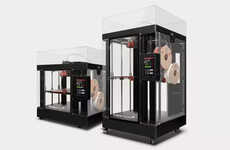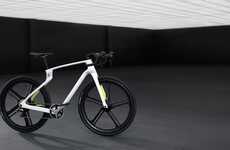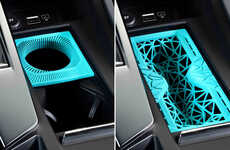
Koenigsegg is Incorporating 3DPrinterOS Into its Production Flow
Colin Smith — September 11, 2023 — Autos
References: koenigsegg & 3dprint
Koenigsegg is a Swedish hypercar manufacturer that is known for creating some of the world’s most exclusive and high-performance vehicles. Founded in 1994 by Christian von Koenigsegg, the company has a history of breaking records and pushing the boundaries of automotive technology. Some of the models that Koenigsegg has produced include the CC8S, the CCX, the Agera, the Regera, and the Jesko. Koenigsegg also develops and produces most of the main systems, subsystems and components for its cars in-house, such as the engines, transmissions, chassis, and carbon fiber bodywork.
One of the technologies that Koenigsegg uses to create its cars is 3D printing. 3D printing allows Koenigsegg to design and manufacture complex and lightweight parts that are not possible with traditional methods. For example, Koenigsegg uses 3D printing to make titanium exhaust tips, turbo housings, air ducts, and even a variable geometry turbocharger. To manage its 3D printing process, Koenigsegg uses 3DPrinterOS, a cloud-based platform that offers features such as printer management, user management, file management, and live monitoring. With 3DPrinterOS, Koenigsegg can streamline its workflow, increase productivity, and scale its business.
Image Credit: Shutterstock
One of the technologies that Koenigsegg uses to create its cars is 3D printing. 3D printing allows Koenigsegg to design and manufacture complex and lightweight parts that are not possible with traditional methods. For example, Koenigsegg uses 3D printing to make titanium exhaust tips, turbo housings, air ducts, and even a variable geometry turbocharger. To manage its 3D printing process, Koenigsegg uses 3DPrinterOS, a cloud-based platform that offers features such as printer management, user management, file management, and live monitoring. With 3DPrinterOS, Koenigsegg can streamline its workflow, increase productivity, and scale its business.
Image Credit: Shutterstock
Trend Themes
1. 3D Printing in Automotive Manufacturing - The use of 3D printing in automotive manufacturing allows for the creation of complex, lightweight parts that cannot be produced with traditional methods, presenting opportunities for increased efficiency and improved performance.
2. Cloud-based 3D Printing Platforms - Cloud-based platforms for managing 3D printing processes enable streamlined workflows, increased productivity, and scalable operations in the manufacturing industry.
3. In-house Production of Car Components - Developing and producing car components in-house allows for greater control over quality and customization, opening up possibilities for innovation and unique designs.
Industry Implications
1. Automotive Manufacturing - The automotive manufacturing industry can leverage 3D printing technology to create advanced and lightweight components, revolutionizing the way vehicles are built.
2. Cloud Computing and Software Services - The cloud computing and software services industry has an opportunity to provide innovative platforms that optimize and manage the 3D printing process for various sectors, including automotive manufacturing.
3. In-house Manufacturing and Design - In-house manufacturing and design in industries such as automotive can drive innovation and customization, as companies have greater control over the production process and can explore novel solutions.
6.7
Score
Popularity
Activity
Freshness
























